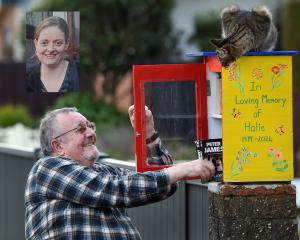He was in Mosgiel after finishing his usual 20km Sunday bike ride on the Taieri.
Back in Dunedin, clinical leader of Dunedin Hospital's cardiology department, Associate Prof Gerry Wilkins, was planning his own bike ride later in the day, after he had mowed the lawns.
Ninety minutes after Mr Summers' symptoms began, Prof Wilkins and his team at the cardiac catheter laboratory had inserted a stent into the patient's troublesome artery.
It was the second stent procedure for 48-year-old Mr Summers.
Three years ago, he joked that he avoided giving his wife Barbara flowers on their 20th wedding anniversary by having a heart attack.
On that occasion, the stent was inserted a day later and he spent six days in hospital.
He returned home so debilitated it took him 45 minutes to walk to the end of his street in Green Island.
This time, he spent three nights in hospital and was feeling "great".
He felt so good the day after his heart attack, he suggested he was ready to go back to work as a representative for Cooke Howlison Toyota.
However, he was banned from driving for four weeks.
His second heart attack was the result of a blockage from a clot and scar tissue in the area of his stent.
Prof Wilkins said the treatment received by Mr Summers had been done during routine working hours and for very high-risk cases for several years.
Recently, the hospital moved to making it the standard treatment for people presenting with bigger heart attacks (called STEMIs ST elevation myocardial infarction).
Previously, when people presented with heart attacks like Mr Summers', a clot-busting drug costing between $1000 and $2000 would have been administered.
An angiogram to assess the narrowing and angioplasty to insert a stent holding the narrowed section open would have been done later.
Prof Wilkins said it had become clear that, in expert centres like Dunedin, if angiograms and angioplasty could be done immediately the patient presented, there was less damage to the patient's heart muscle and the patient's long-term prognosis was improved.
What was really important, however, was that patients having heart attacks got to hospital quickly.
Patients needed to be seen in the first 60 minutes after the onset of symptoms.
"The sooner we can get the artery open, the smaller the heart attack."
Three cardiologists and a team of technical, radiography and nursing staff carry out the work as required around the clock.
The team, once it had received the alert from the emergency department team, could start the procedure within about 30 minutes, he said.












